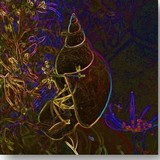PROTEOLYST
 |
Molecular analysis of the response to selection in a hermaphrodite organism exposed to diquat |
|
Research
Context and Issues
Aquatic ecosystems are subject to multiple stressors that are induced by human activities. This occurs in freshwater environments in agricultural landscapes, where stressors can be chemical in origin (pesticides and fertiliser) and/or physical (temporary drying). In this context, pesticides can contaminate ponds and ditches near the treated fields and generate specific eco-evolutionary conditions for non-targeted organisms. Crop protection programs, which usually involve a complex cocktail of substances, make the environment both heterogeneous and unpredictable, which potentially limits the selective processes for local adaptation in exposed populations. Environmental instability may increase the effects of genetic drift (e.g., a decrease in population during drying out periods) and thereby decrease the efficacy of selection. In simultaneous hermaphrodites, such as basommatophoran gastropod molluscs, these conditions may increase self-fertilisation rates that are higher than those predicted by classic evolutionary theory. The resulting level of inbreeding may influence the response to selection.
Objectives
The project focuses on the evolutionary consequences for gene expression that are induced by chemical stress related to human activities. Specific objectives are: 1) to test the occurrence of rapid selection at this molecular level, and 2) to estimate the extent that inbreeding influences these processes in natural populations.Methodology
The study addresses the molecular pathways involved in the general stress response, such as those triggered by environmental changes to which the organism is aware/not aware. The study focuses on the pond snail, Lymnaea stagnalis, a model species in ecotoxicology which is representative of lentic aquatic ecosystems and commonly found in anthropised environments such as agricultural landscapes (ditches, ponds). As a simultaneous hermaphrodite, L. stagnalis can reproduce through cross-fertilisation or self-fertilisation. The latter rapidly induces a high level of inbreeding.
Several assumpts will be tested by studying the differential expression induced by direct exposure to a pro-oxidant pesticide (herbicide diquat) in several generations of self-fertilised and cross-fertilised lines previously exposed to diquat or to test conditions. The project is based on a proteogenomic approach which combines (1) shotgun proteomic analysis based on tandem mass spectrometry using an orbitrap analyser, and (2) genomic resources available in L. stagnalis (annotated genome, differential transcriptomic expression that is induced by exposure to diquat).
Expected Results
The acquired data will be compared to assumptions on the adaptive mechanisms involved: transcriptional plasticity and signal transduction vs the selective process (genetic adaptation to diquat), the influence of self-fertilisation, i.e., facilitation vs moderation of the selection response. The project is based on an extended molecular knowledge base for L. stagnalis. This information, beyond scientific relevance (the potential to develop new ecotoxicological and eco-evolutionary hypotheses) also has a socio-economic perspective, which will be useful to fine-tune methods for ecological risk assessment and chemical regulation. This will facilitate the development of high-resolution molecular biomarkers and their integration in OECD-supported advanced tools (see Adverse Outcome Pathway knowledge base for molecular screening and toxicogenomics). This perspective extends the scope of this project into predictive ecotoxicology.
People involved
 |
BOISSEAUX Paul, Scientist Phone : +33 2 23 48 52 37 Email : paul.boisseaux@inrae.fr |
 |
COLLINET Marc, Technician Phone : +33 2 23 48 55 29 Email : marc.collinet@inrae.fr |
 |
COUTELLEC Marie-Agnès, Scientist Phone : +33 2 23 48 52 48 Email : marie-agnes.coutellec@inrae.fr |
 |
VASSAUX Danièle, Technician Phone : +33 2 23 48 56 69 Email : daniele.vassaux@inrae.fr |
Partners
Funding and Support
- CNRS EC2CO
- Université Bretagne-Loire département EUTES
- Région Bretagne
